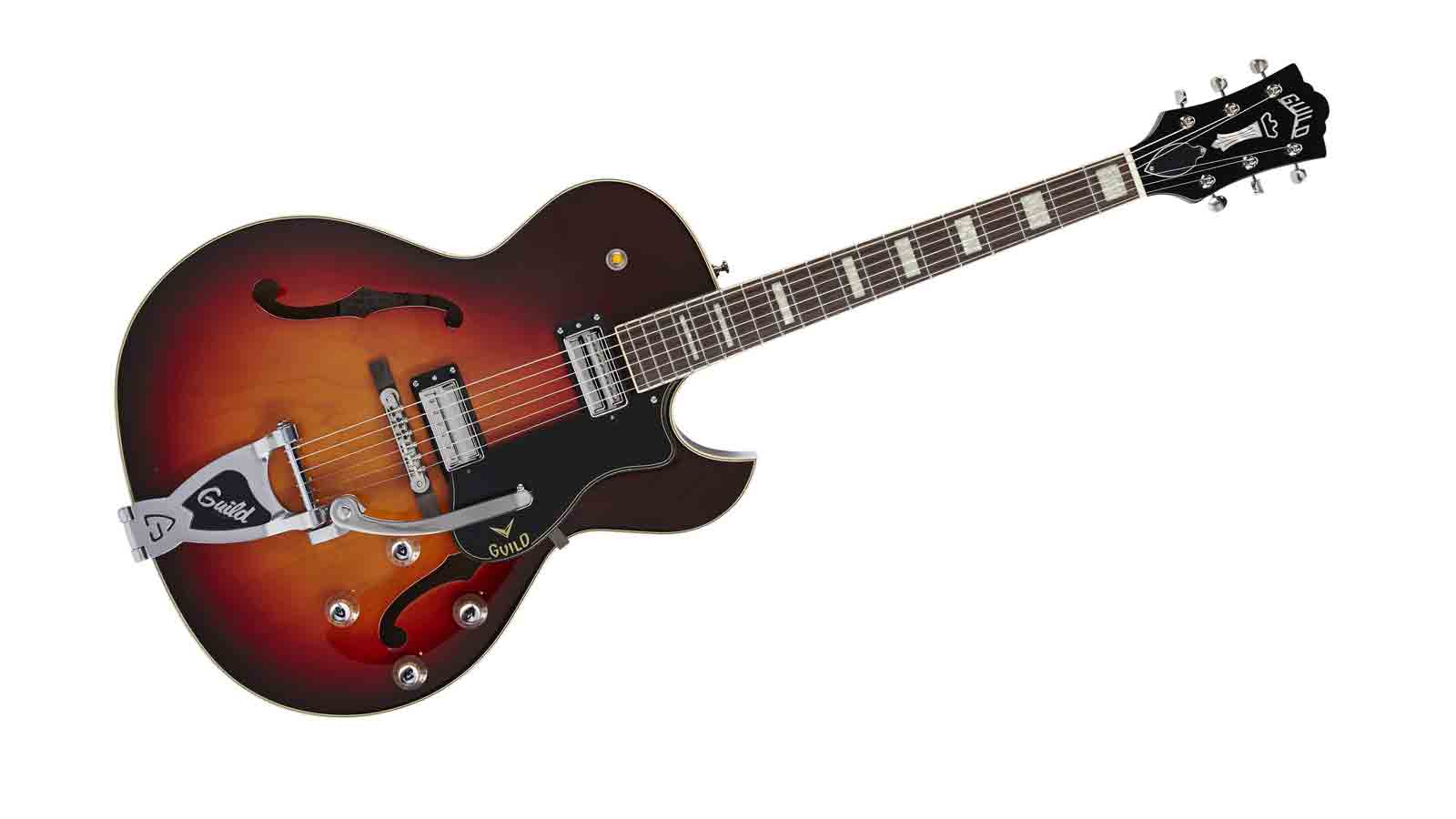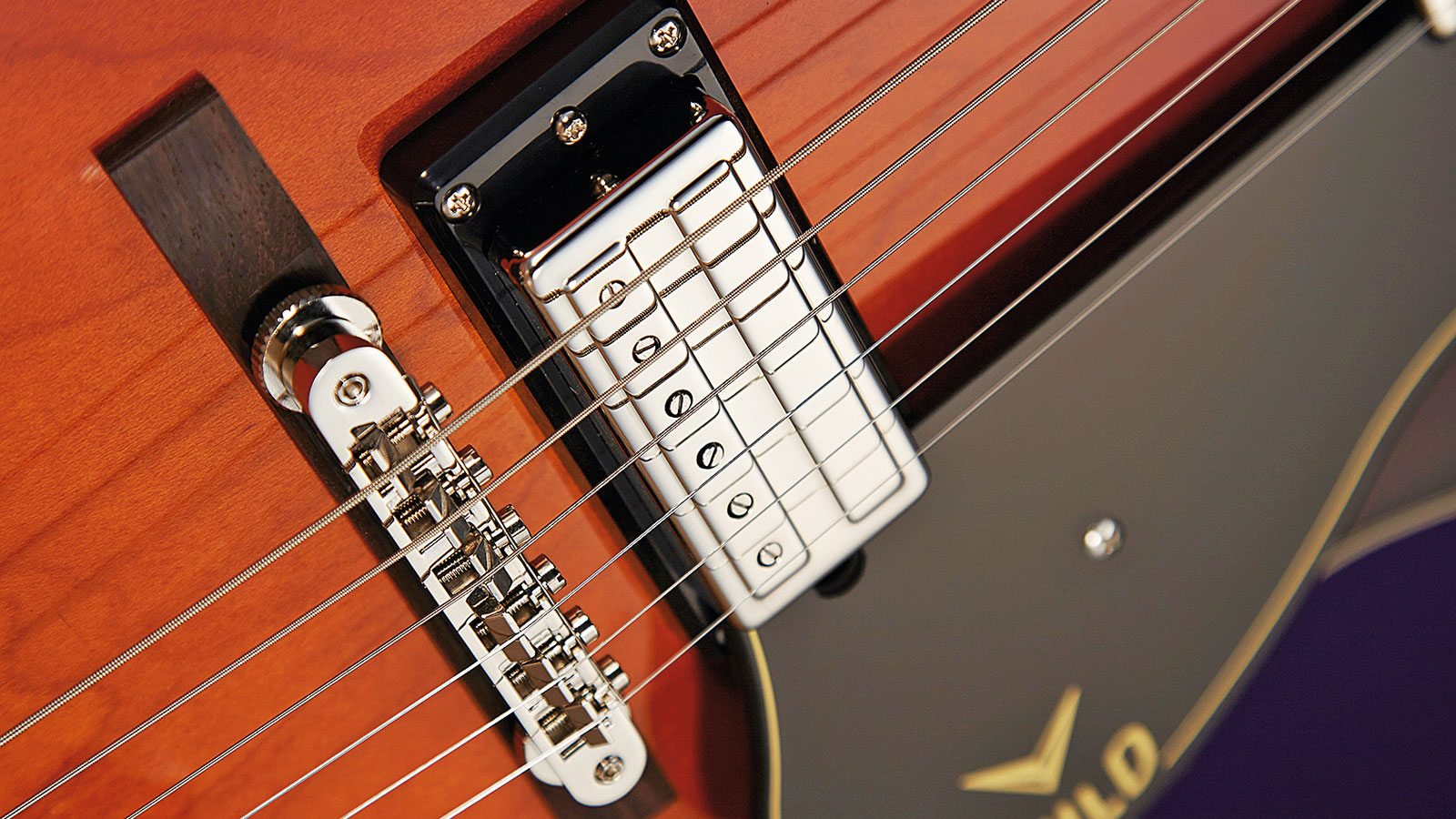MusicRadar Verdict
Guild's version of the ES-175 takes you from jazz to way beyond. With aggressive street pricing, it's hard not to like.
Pros
- +
Quality build. Classic, high standard feel. Superb playability.
Cons
- -
Onstage volume/feedback may be an issue.
MusicRadar's got your back

Guild CE-100D Capri with Bigsby

Bridge

Vibrato

Headstock
Although a limited number of Guild electrics are made in the USA, with appropriately high prices, the main thrust of its 2013 electric return comes in the form of the Newark St Collection, designed in the USA but made in Korea. With the addition of the 2014 CE-100D Capri with Bigsby reviewed here, the range now sports three Starfires, single- and double-cutaways, the jazzier Venetian cutaway Manhatten and Savoy hollowbodies, the smaller M-75 Aristocrat and a pair of basses.
The hollowbody Capri is effectively a deep-body version of the thinline Starfire III. The 1956 Capri CE-100 was the brand's first sharp-pointed 'Florentine' cutaway guitar, although it retained its jazz-era roots with a single neck pickup (the dual-pickup version appeared in 1959), archtop-like wooden bridge and deep body.
The New Breed
At just over 413mm (16 inches) wide, the Capri takes its style from the ES-175, Gibson's first Florentine cutaway electric, that debuted in 1949. Construction is pretty similar: the all-laminate (maple) build is extremely clean - internally kerfed linings join the top and back to the sides and the top is braced with two chunky, longitudinal bars.
"The all-laminate (maple) build is extremely clean"
There are no figured outer veneers - the top has a dark brown sunburst, the back and sides a deep brown 'mahogany' colouration. Weight isn't excessive, and played seated it's a remarkably comfortable design. The onboard Bigsby isn't a jazz standard, and moves the Starfire design into a more Grestch-y area - including the unpinned wooden foot tune-o-matic-style bridge.
There's a high level of vintage-like detail, however, from the Grover Sta-Tite open-backed tuners on the centre-raised 60s-style headstock, with its 'Chesterfield' inlay to the period correct clear amber control knobs - each with a pin marker.
The pickups here replicate the early-60s introduced 'Anti Hum Pickups', and wouldn't have graced the earliest Capris, but controls are Gibson-standard with a shoulder-placed three-way toggle and individual pickup volume and tone controls.
Feel & Sounds
"Sound-wise, the Capri drops right into the 50s and 60s"
The guitar feels classic; it is set up to a high standard, and plays superbly. Sound-wise, the Capri drops right into the 50s and 60s. These pickups, especially the bridge, sound very much like single coils, and the bright rockabilly attack of the bridge is quite a contrast to the more humbucking-like, jazzier neck.
With both pickups on, you can't help but slip into a duck walk or peel off early Stones, Beatles and Kinks licks. Adding a little grit takes us to Chicago, then on to Eel Pie Island, stopping off at Olympic Studios.
It's drenched in the evocative history of jazz, blues, rock 'n' roll and soul, which still forms the cornerstone of many modern bands. Of course, it's a deep hollowbody, so stage volume may cause problems.
There really is no shortage of semis to choose from, but Guild's heritage is quite a draw: the lesser- known 'new' boys to Gibson and even Epiphone's more stately pasts give a real feel of 60s modernism: the change from the jazz era to new rock 'n' roll and pop and the first golden age of the electric guitar.
We'd happily use the Capri for recording and small ensemble gigs and, with attractive street pricing, you could buy this and the new Bigsby-equipped Guild Starfire V for less than a new basic Gibson ES-335. Food for thought?
Dave Burrluck is one of the world’s most experienced guitar journalists, who started writing back in the '80s for International Musician and Recording World, co-founded The Guitar Magazine and has been the Gear Reviews Editor of Guitarist magazine for the past two decades. Along the way, Dave has been the sole author of The PRS Guitar Book and The Player's Guide to Guitar Maintenance as well as contributing to numerous other books on the electric guitar. Dave is an active gigging and recording musician and still finds time to make, repair and mod guitars, not least for Guitarist’s The Mod Squad.
“A synthesizer that is both easy to use and fun to play whilst maintaining a decent degree of programming depth and flexibility”: PWM Mantis review
“I feel like that song had everything we needed to come back with”: Bring Me The Horizon’s Lee Malia on Shadow Moses, its riff and the secrets behind its tone, and why it was the right anthem at the right time
“I said, ‘Are we sure we can write a song about death?’”: The story of Mike + The Mechanics' classic No.1 The Living Years










